NCERT Solutions for Chapter 8 Quadrilaterals Class 9 Maths
Book Solutions1
Answer
Let the angles of the quadrilateral be 3x, 5x, 9x and 13x.∵ Sum of all the angles of quadrilateral = 360º
∴ 3x + 5x + 9x + 13x = 360º ⇒ 30x = 360º
⇒ x=(360°/30)= 12°
∴ 3x = 3 x 12° = 36º 5x
= 5 x 12° = 60º 9x = 9 x 12°
= 108º 13x = 13 x 12° = 156º
⇒ The required angles of the quadrilateral are 36º, 60º, 108º and 156º.
2
Answer

A parallelogram ABCD such that AC = BD
In ΔABC and ΔDCB, AC = DB [Given]
AB = DC [Opposite sides of a parallelogram]
BC = CB [Common]
ΔABC ≌ ΔDCB [SSS criteria]
∴ Their corresponding parts are equal.
⇒ ∠ABC = ∠DCB …(1)
∵ AB || DC and BC is a transversal. [∵ ABCD is a parallelogram]
∴ ∠ABC + ∠DCB = 180º [Interior opposite angles are supplementary] …(2)
From (1) and (2), we have ∠ABC = ∠DCB = 90º
i.e. ABCD is parallelogram having an angle equal to 90º.
∴ ABCD is a rectangle.
3
Answer
We have a quadrilateral ABCD such that the diagonals AC and
BD bisect each other at right angles at O.
∴ In ΔAOB and ΔAOD, we have AO = AO [Common]
OB = OD [Given that O in the mid-point of BD]
∠AOB = ∠AOD [Each = 90°]
∴ ΔAOB ≌ ΔAOD [SAS criteria]
⇒ Their corresponding parts are equal. ∴ AB = AD …(1)
Similarly,
AB = BC …(2)
BC = CD …(3)
CD = AD …(4)
∴ From (1), (2), (3) and (4),
we have AB = BC = CD = DA Thus, the quadritateral ABCD is a rhombus.
4
Answer
We have a square ABCD such that its diagonals AC and BD intersect at O.
(i) To prove that the diagonals are equal, i.e. AC = BD In ΔABC and ΔBAD, we have
AB = BA [Common]
BC = AD [Opposite sides of the square ABCD]
∠ABC = ∠BAD [All angles of a square are equal to 90º]
∴ DABC ≌ DBAD [SAS criteria]
⇒ Their corresponding parts are equal.
⇒ AC = BD …(1)
(ii) To prove that ‘O’ is the mid-point of AC and BD.
∵ AD || BC and AC is a transversal. [∵ Opposite sides of a square are parallel]
∴ ∠1 = ∠3 [Interior alternate angles]
Similarly, ∠2= ∠4 [Interior alternate angles]
Now, in ΔOAD and ΔOCB, we have AD = CB [Opposite sides of the square ABCD]
∠1= ∠3 [Proved ∠2= ∠4 ]
∴ ΔOAD ≌ ΔOCB [ASA criteria]
∴ Their corresponding parts are equal.
⇒ OA = OC and OD = OB ⇒ O is the mid-point of AC and BD,
i.e. the diagonals AC and BD bisect each other at O. …(2)
(iii) To prove that AC ⊥ BD.
In ΔOBA and ΔODA, we have OB = OD [Proved]
BA = DA [Opposite sides of the square]
OA = OA [Common]
∴ ΔOBA ≌ ΔODA [SSS criteria]
⇒ Their corresponding parts are equal.
⇒ ∠AOB = ∠AOD
But ∠AOB and ∠AOD form a linear pair.
∴ ∠AOB + ∠AOD = 180º
⇒ ∠AOB = ∠AOD = 90º
⇒ AC ⊥ BD …(3)
From (1), (2) and (3), we get AC and BD are equal and bisect each other at right angles.
5
Answer
We have a quadrilateral ABCD such that ‘O’ is the mid-point of AC and BD.
Also AC⊥BD.
Now, in ΔAOD and ΔAOB, we have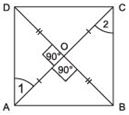
AO = AO [Common]
OD = OB [∵ O is the mid-point of BD]
∠AOD = ∠AOB [Each = 90º]
∴ ΔAOD ≌ ΔAOB [SAS criteria]
∴ Their corresponding parts are equal.
⇒ AD = AB …(1)
Similarly, we have AB = BC …(2)
BC = CD …(3)
CD = DA …(4)
From (1), (2), (3) and (4) we have:
AB = BC = CD = DA
∴ Quadrilateral ABCD is having all sides equal.
In ΔAOD and ΔCOB, we have
AO = CO [Given]
OD = OB [Given]
∠AOD = ∠COB [Vertically opposite angles]
∴ ΔAOD ≌ ΔCOB
⇒ Their corresponding parts are equal. ⇒ ∠1= ∠2
But, they form a pair of interior alternate angles.
∴ AD || BC
Similarly, AB || DC
∴ ABCD is a parallelogram.
∵ Parallelogram having all of its sides equal is a rhombus.
∴ ABCD is a rhombus.
Now, in ΔABC and ΔBAD, we have AC = BD [Given]
BC = AD [Proved]
AB = BA [Common]
∴ ΔABC ≌ ΔBAD [SSS criteria]
⇒ Their corresponding angles are equal.
∴ ∠ABC = ∠BAD
Since, AD || BC and AB is a transversal.
∴ ∠ABC + ∠BAD = 180º [Interior opposite angles are supplementary]
i.e. The rhombus ABCD is having one angle equal to 90º.
Thus, ABCD is a square.
6

(i) it bisects ∠ C also,
(ii) ABCD is a rhombus.
Answer
We have a parallelogram ABCD in which diagonal AC bisects ∠A.
⇒ ∠DAC = ∠BAC
(i) To prove that AC bisects ∠C.
∵ ABCD is a parallelogram.
∴ AB || DC and AC is a transversal.
∴ ∠1 = ∠3 [Alternate interior angles] …(1)
Also, BC || AD and AC is a transversal.
∴ ∠2 = ∠4 [Alternate interior angles] …(2)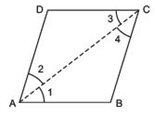
But AC bisects ∠A [Given]
∴ ∠1 = ∠2 …(3)
From (1), (2) and (3), we have
∠3= ∠4
⇒ AC bisects ∠C.
(ii) To prove ABCD is a rhombus.
In DABC, we have
∠1= ∠4 [∵ ∠1 = ∠2 = ∠4]
⇒ BC = AB [Sides opposite to equal angles are equal] …(4)
Similarly,
AD = DC …(5)
But ABCD is a parallelogram [Given]
∴ AB = DC [Opposite sides of a parallelogram] …(6)
From (4), (5) and (6), we have
AB = BC = CD = DA
Thus, ABCD is a rhombus.
7
Answer
ABCD is a rhombus.
∴ AB = BC = CD = AD
Also, AB || CD an AD || BC
Now, AD = CD ⇒ ∠1 = ∠2 …(1)
[Angles opposite to equal sides are equal]
Also, CD || AB [Opposite sides of the parallelogram]
and AC is AC is transversal.
∴ ∠1= ∠3 [Alternate interior angles] …(2)
From (1) and (2), we have
∠2= ∠3 and ∠1 = ∠4
⇒ AC bisects ∠C as well as ∠A.
Similarly, we prove that BD bisects ∠B as well as ∠D.
8
ABCD is a rectangle in which diagonal AC bisects ∠ A as well as ∠ C. Show that:
(i) ABCD is a square
(ii) diagonal BD bisects ∠ B as well as ∠ D.
Answer
We have a rectangle ABCD such that AC bisects ∠ A as well as ∠C.
i.e. ∠ 1= ∠ 4 and ∠ 2 = ∠ 3 ...(1)
(i) Since, rectangle is a parallelogram.
∴ ABCD is a parallelogram.
⇒ AB || CD and AC is a transversal.
∴ ∠2= ∠4 [Alternate interior angles] ...(2)
From (1) and (2), we have
∠3= ∠4
⇒ AB = BC [∵ Sides opposite to equal angles in D ABC are equal.]
∴ AB = BC = CD = AD
⇒ ABCD is a rectangle having all of its sides equal.
∴ ABCD is a square.
(ii) Since, ABCD is a square, and diagonals of a square bisect the opposite angles.
∴ BD bisects ∠B as well as ∠D.
9

(i) ΔAPD ≌ ΔCQB
(ii) AP = CQ
(iii) ΔAQB ≌ ΔCPD
(iv) AQ = CP
(v) APCQ is a parallelogram.
Answer
We have parallelogram ABCD. BD is a diagonal and ‘P’ and ‘Q’ are such that
PD = QB [Given]
(i) To prove that ΔAPD ≌ ΔCQB
∵ AD || BC and BD is a transversal. [∵ ABCD is a parallelogram.]
∴ ∠ADB = ∠CBD [Interior alternate angles]
⇒ ∠ADP = ∠CBQ
Now, in ΔAPD and ΔCQB, we have
AD = CB [Opposite side of the parallelogram]
P D = QB [Given]
∠CBQ = ∠ADP [Proved]
∴ Using SAS criteria, we have ΔAPD ≌ ΔCQB
(ii) To prove that AP = CQ
Since, ΔAPD ≌ ΔCQB [Proved]
∴ Their corresponding parts are equal.
⇒ AP = CQ
(iii) To prove that ΔAQB ≌ ΔCPD.
∵ AB || CD and BD is a transversal. [∵ ABCD is a parallelogram.]
∴ ∠ABD = ∠CDB
⇒ ∠ABQ = ∠CDP
Now, in ΔAQB and ΔCPD,
we have QB = PD [Given]
∠ABQ = ∠CDP [Proved]
AB = CD [Opposite sides of parallelogram ABCD]
∴ ΔAQB ≌ ΔCPD [SAS criteria]
(iv) To prove that AQ = CP.
Since, ΔAQB ≌ ΔCPD [Proved]
∴ Their corresponding parts are equal.
⇒ AQ = CP.
(v) To prove that APCQ is a parallelogram.
Let us join AC.
Since, the diagonals of a || gm bisect each other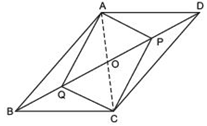
∴ AO = CO …(1)
and BO = DO
⇒ (BO ∠ BQ) = (DO ∠ DP) [∵ BQ = DP (Given)]
⇒ QO = PO …(2)
Now, in quadrilateral APCQ,
We have, AO = CO and QO = PO
[from (1) and (2)]
i.e. AC and QP bisect each other at O.
⇒ APCQ is a parallelogram.
10
Show that (i) ΔAPB ≌ ΔCQD (ii) AP = CQ
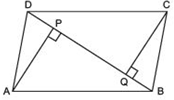
Answer
(i) In ΔAPB and ΔCQD, we have
∠APB = ∠CQD [90º each]
AB = CD [Opposite sides of parallelogram ABCD]
∠ABP = ∠CDQ [AB || CD and AB is a transversal]
⇒ Using AAS criteria, we have ΔAPB ≌ ΔCQD
(ii) Since, ΔAPB ≌ ΔCQD [Proved]
∴ Their corresponding parts are equal.
⇒ AP = CQ
11

(i) quadrilateral ABED is a parallelogram.
(ii) quadrilateral BEFC is a parallelogram.
(iii) AD || CF and AD = CF.
(iv) quadrilateral ACFD is a parallelogram.
(v ) AC = DF
Answer
(i) To prove that ABED is a parallelogram.
Since “A quadrilateral is a parallelogram if a pair of opposite sides is parallel and is of equal length.” Now AB = DE [Given]
AB | | DE [Given]
i.e. ABED is a quadrilateral in which a pair of opposite sides (AB and DE) is parallel and of equal length.
∴ ABED is a parallelogram.
(ii) To prove that BECF is a parallelogram.
∵ BC = EF [Given]
and BC || EF [Given]
i.e. BECF is a quadrilateral in which a pair of opposite sides (BC and EF) is parallel and of equal length.
∴ BECF is a parallelogram.
(iii) To prove that AD || CF and AD = CF ∵ ABED is a parallelogram. [Proved]
∴ Its opposite sides are parallel and equal.
⇒ AD || BE and AD = BE …(1)
Also BEFC is a parallelogram. [Proved]
∴ BE || CF and BE = CF [∵ Opposite sides of a parallelogram are parallel and equal] …(2)
From (1) and (2), we have
AD || CF and AD = CF
(iv) To prove that ACFD is a parallelogram.
∵ AD || CF [Proved] and
AD = CF [Proved]
i.e. In quadrilateral ACFD, one pair of opposite sides (AD and CF) is parallel and of equal length.
∴ Quadrilateral ACFD is a parallelogram.
(v) To prove that AC = DE.
∵ ACFD is a parallelogram. [Proved]
∴ Its opposite sides are parallel and of equal length. i.e. AC = DF
(vi) To prove that ΔABC ≌ ΔDEF In D ABC and DDEF, we have:
AB = DE [Opposite sides of a parallelogram]
BC = EF [Opposite sides of a parallelogram]
AC = DF [Proved]
∴ Using SSS criteria, we have ΔABC ≌ ΔDEF.
12
ABCD is a trapezium in which AB || CD and AD = BC (see figure).
Show that
(i) ∠ A = ∠ B
(ii) ∠ C = ∠ D
(iii) ∠ ABC ≌ ∠ BAD
(iv) Diagonal AC = Diagonal BD
Hint: Extend AB and draw a line through C parallel to DA intersecting AB produced at E.
Answer
We have AB || CD and AD = BC
(i) To prove that ∠A = ∠B.
Produce AB to E and draw CE || AD.
∴ AB || DC
⇒ AE || DC [Given]
Also AD || CE [Construction]
∴ AECD is a parallelogram.
⇒ AD = CE [opposite sides of the parallelogram AECD]
But AD = BC [Given]
∴ BC = CE
Now, in ΔBCE, we have
BC = CE
⇒ ∠CBE = ∠CEB …(1)
[∵ Angles opposite to equal sides of a triangle are equal]
Also, ∠ABC + ∠CBE = 180° [Linear pair] ...(2)
and ∠A + ∠CEB = 180° [∵ Adjacent angles of a parallelogram are supplementary] …(3)
From (2) and (3), we get
∠ABC + ∠CBE = ∠A + ∠CEB
But ∠CBE = ∠CEB [Using (1)]
∴ ∠ABC = ∠A
or ∠B= ∠A
or ∠A= ∠B
(ii) To prove that ∠C = ∠D.
AB || CD and AD is a transversal.
∴ ∠A + ∠D = 180º [Sum of interior opposite angles]
Similarly, ∠B + ∠C = 180º
⇒ ∠A + ∠D= ∠B + ∠C
But ∠A= ∠B [Proved]
∴ ∠C= ∠D
(iii) To prove ΔABC ≌ ΔBAD
In ΔABC and ΔBAD, we have
AB = BA [Common]
BC = AD [Given]
∠ABC = ∠BAD [Proved]
∴ ΔABC ≌ ΔBAD [Using SAS criteria]
(iv) To prove that diagonal AC = diagonal BD ∵
ΔABC ≌ ΔBAD [Proved]
∴ Their corresponding parts are equal.
⇒ the diagonal AC = the diagonal BD.
1
(i) SR || AC and SR = (1/2) AC
(ii) PQ = SR
(iii) PQRS is a parallelogram.

Answer
We have P as the mid-point of AB, Q as the mid-point of BC, R as the mid-point of CD, S as the mid-point of DA, and AC as the diagonal of quadrilateral ABCD.
(i) To prove that SR =(1/2) AC and SR || AC.
In ΔACD, we have
S as the mid-point of AD, R as the mid-point of CD.
∵ The line segment joining the mid-point of any two sides of a triangle is parallel to the third side and half of it.
∴ SR = (1/2)AC and SR || AC
(ii) To prove that PQ = SR.
In ΔABC, we have P is the mid-point of AB, Q is the mid-point of BC.
∴ PQ = (1/2) AC …(1)
Also, SR = (1/2) AC [Proved] …(2)
From (1) and (2),
PQ = SR
(iii) To prove that PQRS is a parallelogram.
In ΔABC, P and Q are the mid-points of AB and BC.
∴ PQ = (1/2)AC and PQ || AC ...(3)
In ΔACD, S and R are the mid-points of DA and CD.
∴ SR = (1/2)AC and SR || AC …(4)
From (3) and (4), we get
PQ =(1/2)AC = SR and PQ || AC || SR
⇒ PQ = SR and PQ || SR
i.e. One pair of opposite sides in quadrilateral PQRS is equal and parallel.
∴ PQRS is a parallelogram.
2
Show that the quadrilateral PQRS is a rectangle.
Answer
We have P as the mid-point of AB, Q as the midpoint of BC, R as the mid-point of CD, S as the mid-point of DS.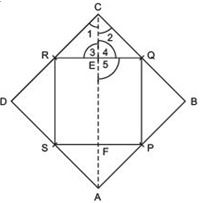
We have to prove that PQRS is a rectangle.
Let us join AC.
∵ In ΔABC, P and Q are the mid-points of AB and BC.
∴ PQ =(1/2)AC and PQ || AC …(1)
Also in ΔADC, R and S are the mid-points of CD and DA.
∴ SR = (1/2)AC and SR || AC
From (1) and (2), we get
PQ =(1/2) AC = SR and PQ || AC || SR
⇒ PQ = SR and PQ || SR
i.e. One pair of opposite sides of quadrilateral PQRS is equal and parallel.
∴ PQRS is a parallelogram.
Now, in ΔERC and ΔEQC,
∠1= ∠2 [∵ The diagonal of a rhombus bisects the opposite angles]
CR = CQ [Each is equal to(1/2) of a side of rhombus]
CE = CE [Common]
∴ ΔERC ≌ ΔEQC [SAS criteria]
⇒ ∠3= ∠4 [c.p.c.t.]
But ∠3 + ∠4 = 180º [Linear pair]
⇒ ∠3= ∠4 = 90°
But ∠5= ∠3 [Vertically opposite angles]
∴ ∠5 = 90º PQ || AC
⇒ PQ || EF
∴ PQEF is a quadrilateral having a pair of opposite sides parallel and one of the angles is 90º.
∴ PQEF is a rectangle.
⇒ ∠RQP = 90º
∴ One angle of parallelogram PQRS is 90º.
Thus, PQRS is a rectangle.
3
Answer
In a rectangle ABCD, P is the mid-point of AB, Q is the midpoint of BC, R is the mid-point of CD, S is the mid-point of DA AC is the diagonal.
Now, in ΔABC,
PQ =(1/2)AC and PQ || AC [Mid-point theorem] …(1)
Similarly, in ΔACD,
SR =(1/2)AC and SR || AC …(2)
From (1) and (2), we get
PQ = SR and PQ || SR
Similarly, by joining BD,
we have PS = QR and PS || QR
i.e. Both pairs of opposite sides of quadrilateral PQRS are equal and parallel.
∴ PQRS is a parallelogram.
Now, in ΔPAS and ΔPBQ,
∠A= ∠B [Each = 90º]
AP = BP [Each = (1/2)AB]
AS = BQ [Each =(1/2) of opposite sides of a rectangle]
∴ ΔPAS ≌ ΔPBQ [SAS criteria]
∴ Their corresponding parts are equal.
⇒ PS = PQ
Also PS = QR [Proved]
and PQ = SR [Proved]
∴ PQ = QR = RS = SP
i.e. PQRS is a parallelogram having all of its sides equal.
⇒ PQRS is a rhombus.
4
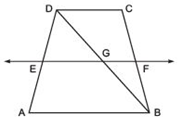
Answer
In trapezium ABCD, AB || DC. E is the mid-point of AD.
EF is drawn parallel to AB.
We have to prove that F is the mid-point of BC.
Join BD.
In DDAB,
∵ E is the mid-point of AD [Given]
and EG || AB [∵ EF || AB]
∴ Using the converse of mid-point theorem, we get that G is the mid-point BD.
Again in DBDC,
∵ G is the mid-point of BD [Proved]
GF || DC [∵ AB || DC and EF || AB and GF is a part of EF]
∴ Using the converse of the mid-point theorem, we get that F is the mid-point of BC.
5
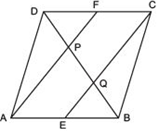
Answer
We have ABCD is a parallelogram such that: E is the mid-point of AB and F is the mid-point of CD.
Let us join the opposite vertices B and D.
Since, the opposite sides of a parallelogram are parallel and equal.
∴ AB || DC ⇒ AE || FC …(1)
Also, AB = DC
or (1/2) AB =(1/2)DC ⇒ AE = FC …(2)
From (1) and (2),
we can say that AECF is quadrilateral having a pair of the opposite sides as parallel and equal.
∴ AEFC is a parallelogram.
⇒ AE || CF
Now, in DDBC,
F is the mid-point of DC [Given]
and FP || CQ [∵ AF || CE]
⇒ P is the mid-point of DQ [Converse of mid-point theorem]
⇒ DP = PQ …(3)
Similarly, in DBAP,
BQ = PQ …(4)
∴ From (3) and (4), we have
DP = PQ = BQ
⇒ The line segments AF and EC trisect the diagonal BD.
6
Answer
A quadrilateral ABCD such that the mid-points of AB, BC, CD and DA are P, Q, R and S respectively, we have to prove that diagonals of PQRS are bisected at O.
Join PQ, QR, RS and SP. Let us also join PR and SQ.
Now, in ΔABC, we have P and Q as the mid-points of its sides AB and BC respectively.
∴ PQ || AC and PQ =(1/2)AC
Similarly, RS || AC and RS =(1/2)AC
⇒ PQRS is a quadrilateral having a pair of opposite sides (PQ and RS) as equal and parallel.
∴ PQRS is a parallelogram.
But the diagonals of a parallelogram bisect each other. i.e. PR and SQ bisect each other.
Thus, the line segments joining the mid-points of opposite sides of a quadrilateral ABCD bisect each other.
7
(i) D is the mid-point of AC
(ii) MD ⊥ AC
(iii) CM = MA =(1/2) AB
Answer
We have a triangle ABC, such that ∠C = 90º M is the mid-point of AB and MD || BC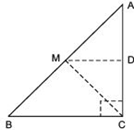
(i) To prove that D is the mid-point of AC.
In ΔACB, we have M as the mid-point of AB. [Given]
MD || BC [Given]
∴ Using the converse of mid-point theorem, D is the mid-point of AC.
(ii) To prove that MD ⊥ AC.
Since, MD || BC [Given] and AC is a transversal.]
∴ ∠ MDA = ∠BCA [Corresponding angles]
But ∠BCA = 90º [Given]
∴ ∠MDA = 90º ⇒ MD ⊥ AC.
(iii) To prove that CM = MA =(1/2) AB
In ΔADM and ΔCDM, we have
∠ADM = ∠CDM [Each = 90º]
MD = MD [Common]
AD = CD [∵ M is the mid-point of AC (Proved)]
∴ ΔADM ≌ ΔCOM [SAS criteria]
⇒ MA = MC [c.p.c.t.] …(1)
∵ M is the mid-point AB. [Given]
∴ MA =(1/2)AB …(2)
From (1) and (2), we have
CM = MA = (1/2) AB